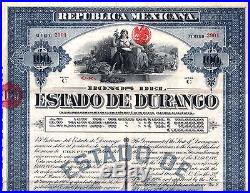
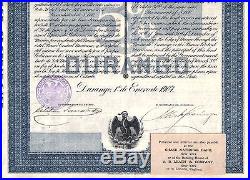
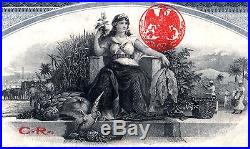
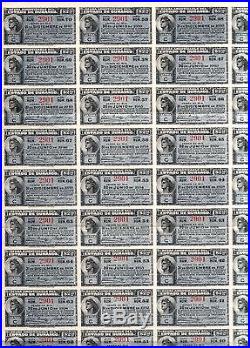
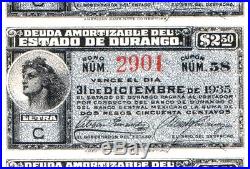

A second one is available with somewhat more wear (still very nice). Here you have one of the most beautiful and RAREST of all Mexican bonds – the blue 100 Peso bond of 1907 issued the the State of Durango. A mere 750 of these bonds was authorized and only a fraction of that amount remains available to collectors today! Exquisitely engraved by the American Bank Note Co, the bond measures an enormous 16″ x 20″ including the superb sheet of 44 coupons, each with the head of a female warrior. The bond and coupons are engraved on both sides so there are a total of 4 large ornate panels! The text is bi-lingual (Spanish and English) and appears in multiple fancy fonts. The reverse of the bond includes all terms and conditions including a red imprint indicating that the bond was underwritten by Banco Central Mexicano. There is a printed panel at the bottom right stating that interest and principal are also payable at the Chase National Bank or A. Leach & Company, London. This bond features one of the largest, most artistic vignettes (steel engraved illustration) on Mexican securities. A beautiful female seated on a throne, a white parrot at her feet, is surrounded by a bounty of nature’s gifts, a sugar refinery and the harvest of tropical fruits. The eleborate designs are further enhanced by 2 red and one purple seals (the latter being that of the State Governor, who has signed the bond by hand along with the State Secretary). The Great Seal of Mexico (the legendary Eagle clasping snake vignette) appears between the signatures. Choice crisp condition with just 3 light folds. A classic and RARE Mexican Estado bond in superb condition!! Estado Libre y Soberano de Durango. State of Durango within Mexico. 24.93472°N 104.91194°W. 24.93472; -104.91194. Yolanda De la Torre. 3,340 m (10,960 ft). The state’s GDP was 104,430.112 million of pesos. Amount corresponding to 8,158.602 millon of dollars. Being a dollar worth 12.80 pesos (value of June 3, 2010). , officially Free and Sovereign State of Durango Spanish. , is one of the 31 states which, with the Federal District. Compose the 32 Federal Entities. The state is located in Northwest Mexico. With a population of 1,632,934, it has Mexico’s second-lowest population density, after Baja California Sur. The city of Victoria de Durango. Is the state’s capital, named after the first president of Mexico, Guadalupe Victoria. Durango, along with the states of Chihuahua, Sonora and Sinaloa, formed the historical and geographical unity of Northern Mexico, for what was the majority of the last millennium; it was not until the territories were reorganized after the independence. Struggle that they emerged as independent entities. This broad area represents the natural corridor that the Sierra Madre Occidental. Offered to the Toltec. Tribes, both whom took advantage of the large accidental stone conformations to survive in the wilderness of the territory. The new formations formed as the only security for the tribes that moved among Northern Mexico and the Valley of Anahuac. Eventually becoming a home-state for these tribes who then began to form small communities, united by language and region. Incorporated perfectly distinct nations, each with evident sedentary purposes, and a strong family structure, all whilst setting aside the bellicose attitude of the Chichimec tribe of the center of the then-current Republic. Sedentary life began in Durango around 500 B. C in response to population growth. The exceptions were the Acaxee. Humas, and Xiximes who were constantly at war but always on the look-out for final settlements in the region of the Quebradas. On the east bank of the state a longitudinal zone can be found, that extends from the current state of Zacatecas. To the la Laguna. Area between the entities of Durango and Coahuila. These Natives of which so little was recorded were the first inhabitants of the region long before they were exterminated by the Spanish. Today, only a few remain of the Tepehuanos, Huicholes, Coras and Tarahumara tribes. By around 200-300 A. D, Durango along with the north central zone (from the Bajio to the states of Durango, Zacatecas and San Luis Potosí) of present day Mexico was inhabited by sedentary groups that were link to the cultures located further south. The state was connected by a broad commercial network that linked it to areas as north as New Mexico and as far south as the valley of Mexico. Captain Francisco de Ibarra. Catedral basílica de Victoria de Durango. Once the province of New Spain. Was established in the rest of the country, new explorers ventured out to conquer Northern Mexico, establishing the province of Nueva Vizcaya. In honor of the Spanish province. Of the same name. The first to colonize Durango, settled this part of the vast northern province of Nueva Vizcaya. On July 8, 1563 he founded the capital city and named it Durango for the Basque town Durango, Biscay. Durango along with the three aforementioned states (Chihuahua, Sonora and Sinaloa), formed part of the province of Nueva Vizcaya. A name that was used during the Colonial Period. To designate the territory discovered by Captain Francisco de Ibarra. Between 1554 and 1567. Several important factors contributed to the region being named Nueva Vizcaya, one was that the valley in which the “Cerro de Mercado” is located had a resemblance to the “Valley of Guardiana” that existed in the province of Biscay. The second reason was the fact that iron mines which were found in Durango also existed in the aforementioned Spanish province of Biscay; reasons of which gave more meaning to the assigned name of the region. Additionally, many of the soldiers who then came on the expedition of Captain Francisco de Ibarra and formalized the conquest of the region, were Basques. Equally important to note is that in 1552 Spanish. Captain, Ginés Vázquez del Mercado, discovered one of the world’s richest iron-ore deposits (now an important part of Durango) which was named after him, present-day Cerro de Mercado. Gradually, in the following decades, the Franciscans. Followed by the Jesuits. Began the evangelization of Nueva Vizcaya, laying the foundations of a large diocese. The towns, Nombre de Dios, Peñol (Peñón Blanco), San Juan Bautista del Río, Analco, Indé, Topia, La Sauceda, Cuencamé and Mezquital arose from the evangelical work of the Franciscan order; Mapimi, Santiago Papasquiaro, Tepehuanes, Guanacevi, Santa Maria del Oro, Tamazula, Cerro Gordo (Villa Ocampo), San Juan de Bocas (Villa Hidalgo) and two establishments that originally belonged to the Franciscans, La Sauceda (Canatlan) and Cuencame, were established by the religious members of the Society of Jesus at the invitation of the Basque. Governor Rodrigo del Río de Lossa. The establishment of garrisons in Northern Mexico, provided security to the people immersed in isolation, a characteristic of the territory. The new routes enjoined the military camps and thus emerged the’Courier of the Provinces’, a government scheme adopted by the Spanish monarchs in 1767. The neo-Basque territory began to split in the colonial period. The first to emerge was the Sinaloa Province, which then included the areas known today as Sonora. Later, the state of Coahuila separated, and with the Constitution of 1824, was divided into provinces creating the states of Durango and Chihuahua, and attaching some municipalities to the state of Zacatecas. Durango did not escape the great national struggle between conservatives. And the capital was taken several times by representatives of both sides, as was the case of siege imposed by Coronado and Patoni in 1858 for the liberal cause, as well as the French intervention that between 1864 and 1866 that occupied the state with the support of conservative forces. At the time that Porfirio Díaz. Was at the head of the Republic, Durango also experienced local dictatorships such as that of Governor Juan Manuel Flores, who held office between 1884 and 1897. Esteban Fernandez, who also became governor, was reelected in 1908 after his four-year term only to leave in 1911. Durango joined the network of railway and telegraph networks that he lay down on the country, resulting in the creation of new regions, as was the case of the Laguna region from which the cities of Lerdo and Gomez Palacio emerged, both now of paramount importance. The railroad also connects the state capital with Mexico City. And the border towns, which allows the marketing of goods produced in the region, and the transportation of mineral resources for exportation. Francisco Villa and his wife, Sra. Maria Luz Corral de Villa (1914). Durango played a very important role in the Mexican Revolution. Important revolutionary figures of extraordinary historical validity in important battles between 1910 and 1924 emerged, such as Francisco Villa. Calixto Contreras and Severino Cenicero, in support of the “Maderistas”, supporters of the ideologies of President Francisco I. On November 21, 1910, Duranguense military personnel Jesús Agustín Castro and Oreste Pereyra, took up arms in the Laguna region commanding a small army that would join the forces of Francisco I. Madero, shortly after his assassination. The splitting of the territories would continue with the government of Enrique R. Calderon, who implemented the provisions of President Lázaro Cárdenas. With the distribution of 100,000 acres 400 km. In the Laguna region of Durango, and the formation of the Municipality of Tlahualilo, shedding Mapimí and Gomez Palacio. At the half century the “educational crusade” began which bestowed upon Durango important colleges of upper education such as Instituto Tecnológico de Durango (Technological Institute of Durango) and Universidad Juarez del Estado de Durango (University of Juarez in Durango). The latter was based on the historical Instituto Juarez (Juarez Institute), which dates back to the eighteenth century. At this time the town of Vicente Guerrero also emerged, separating itself from Suchil an action which resulted in completion of the geographical pattern which now is the state of Durango, with modern means of communication that in the form of paved roads connects most of the municipalities with the capital and connects the capital with the important cities across the country. The last years are representative of the rural. Exodus to the main cities of the entity, requiring the implementation of numerous development services, that completely changed the traditional image of the Colonial. Durango that seemed rooted in the style of life of most of its inhabitants. This was a late colonization for the Spanish, due mostly to heavy resistance by the indigenous population. From first contact to modern times, the indigenous peoples have attempted to gain some autonomy, address grievances, and maintain traditional land ownership. Spanish colonists became highly attracted to the Durango area for its mining and grazing prospects. In 1823, shortly after victory over Spain in the Mexican War of Independence. Durango earned the right to become a separate state. In Tamazula, Durango, Mexico. Durango is the fourth largest state in Mexico. The state is bordered to the north by Chihuahua. To the north-east by Coahuila. To the south-east by Zacatecas. To the south-west by Nayarit. And to the west by Sinaloa. With an average elevation of almost 2,000 metres (6,600 ft), most of the state is heavily mountainous and a good part forested; the Sierra Madre Occidental. Occupies two thirds of the state, mostly in the western and central part of the state. In the western parts of the Sierra Madre, the geography is characterized by deep ravines and rivers that mostly flow westward. The highest point in the state is Cerro Gordo at 3,340 m (10,960 ft) above sea level. This mountain range contains a good supply of minerals, including the silver that encouraged Spanish occupation of the territory after it was discovered. These mines extend north into Chihuahua. And south into the state of Zacatecas. Vast desert basins in the Laguna District are irrigated by the Nazas River. In summer, the average maximum range from. In the eastern parts of the state to a low of. In the western parts. In winter, the max ranges from. To a low of. Except for the mountainous areas and small lowland areas in the west such the Quebradas area, the state is fairly dry because the Sierra Madre blocks most of the humid air coming in from the Pacific coast. The climate in the mountains tends to be cool with snowfalls common in winter and have heavier precipitation in the summer than the rest of the state. However, the snow that falls does not linger for long and melts. The average temperature reaches a maximum of. In June in the Sierra Madre. Precipitation is highly seasonal with 70-80% of the precipitation falling from June to September. East of the Sierra Madre, the climate is drier and warmer and precipitation is just enough to support agriculture. Most of the precipitation in the state fall during the summer months, owing to the development of the monsoon. In southern Mexico that moves northward to reach the northern states and parts of USA by July. Drought like conditions and extreme changes in temperatures are common in the central parts. Owing to the contrast in climatic conditions, between January and April, the state has strong winds that run from the southeast. The average precipitation in the state varies from a low of 273 millimetres (11 in) in Ciudad Lerdo in the far-eastern part of the state to 890 millimetres (35 in) in El Salto in the west. Major crops grown in the area include cotton. Durango is famous for its scorpions. The scorpion is a common symbol representing the state. Mexicans generally refer to the people of Durango as Alacrán de Durango (Scorpions from Durango). The demonym for the natives of Durango is Duranguense(s). The major occupations in Durango are farming, lumbering, mining, and ranching. The land of cinema. Durango is known nationally and even internationally for two reasons: one being that it is “the land of the scorpions” due to the many species of scorpions in the state, especially in the colonial areas, and second as the land of cinema. Durango has among its credits over 120 film productions, both domestic and foreign, and as a result, during the decades of the 1950s, 60s, 70s and 80s, had earned that title. Durango has established itself as one of the favorite places of film producers and directors due to its picturesque views and scenic beauty. Film had arrived in a train heading to Durango in 1889; when the Mexican Revolution. Began in 1910, film producer Raoul Walsh. Recorded the battles of General Francisco Villa. These scenes were included in the film The Life of General Villa. Griffith, and directed by Christy Cabanne. Hollywood had discovered Durango in the mid-century. In 1954, the film industry officially entered the state; American film art director Jack Smith. Had flown over Durango and was instantly seduced by the landscape. Subsequently, the first movie filmed in Durango was White Feather. Directed by Robert D. Durango also had close ties with John Wayne. The close friendship between Durango and John Wayne, an American actor and icon of Western. Movies, started in 1965, and resulted in the making of the films The Sons of Katie Elder. Such was the amount of time that Wayne spent filming in Durango, that he acquired a ranch in the state. Basque conquerors who founded Durango and began the conquest of the northern territory brought their recipes and the first herds. Among the dishes from Durango, is “caldillo”, particularly noted for its antiquity. Along with beef it can be prepared with chile verde (green chile), chile Colorado (red chile), or chile pasado (dehydrated green chiles). The broth is the first culinary preparation in the long history of culture in Durango, and demonstrates the influence of cultures that have been in the genesis of Durango. Its origin goes back to the days of Basque. Captain Francisco de Ibarra; one of the first conceptions appears in an old manuscript that belonged to wealthy miner and landowner, Joseph del Campo Soberón and Larrea Soberon, the Count of Súchil Valley. Durango is also known for its marmalades and preserves made from quince, figs, and peaches, as well as the native pitahaya. Gallina Borracha or’drunken chicken’ is a dish unique to Durango, made mostly of Spanish ingredients, such as raisins, sherry and almonds. Traditional drinks include Licor de Membrillo , a liquor made from quince. Durango is also known for its cheese, in particular queso chihuahua. Also called’ queso menonita’ , a type of cheese made by the state’s numerous Mennonite. Residents as well as the traditional Queso Ranchero usually made in the high Sierra’s (mountains) of Durango which tourists as well as native’s like to enjoy. Another plate unique to Durango (usually more to North Western Durango) is Venorio made with pork ribs cut into pieces, nopales (cactus) and a special chile sauce made with different ground seeds of pumpkin as well as chile seeds, and has a distinctive orange look to the sauce. Carne seca (beef jerky) is also another traditional food that can be used to make machaca con huevo (jerkey with eggs) and caldillo con papas (jerkey with potato soup). The people from Durango also enjoy traditional Mexican. Dishes, such as tamales. As well as quesadillas made with the two cheese mentioned above. Durango consists of geographical diversity which allows sports enthusiasts to participate in extreme sports. And more; Durango is also home to a quantity of gorges. That measure 80 feet (24 m) one of which is Salto del Agua LLovida. The state also has numerous lakes that measure over 800 meters in diameter such as Lago de Puentecillas (Puentecillas Lake). According to the last census that took place in 2005, Durango, with just over a million and a half inhabitants, occupies the 24th position within the 32 federal entities regarding population, and reports an average growth rate so low that it would take more than 250 years to double its number of inhabitants. At least 2% of the population over 5 years of age speak an indigenous language, 80% of which belong to the Tepehuan. Ethnic group, which is indigenous to the state. Other smaller indigenous groups include the Huichol. The latter of an unknown descent and who speak a variety of Nahuatl. Roughly 20,000 German-speaking Mennonites. Reside in secluded communities throughout the semi-desertic region of the state. 90% of the state population are baptized Catholics. Which are mostly concentrated in the rural areas; the urban areas of the state contain significant religious minorities consisting of Protestants. Despite the low demographic density it contains, only 12 inhabitants per km. 60% of the population is concentrated in only three of the 39 state municipalities: Durango. The rest live in small and disperse localities, for as much as 6,258 communities can be found in the state, 82% of which have fewer than 100 inhabitants. Some 67% of the population lives in urban areas, below the 76% national average. Even so, the migration of people from the rural zones towards urban environments represents a serious issue for the government of Durango, because it implies satisfying a high demand for public services and utilities. Durango is divided into 39 municipalities. (first president of Mexico). S song, Romance in Durango. , is on his Desire. Also famous is Fabrizio De Andrè. S “Avventura in Durango”, an Italian version of “Romance in Durango”. Released the song “The Man From Durango” on their album Wing Ding in 1993. The item “CHOICE CRISP BLUE 1907 ESTADO DURANGO MEXICO BOND w 44 COUPONS! SPECTACULAR FIND” is in sale since Friday, May 10, 2013. This item is in the category “Coins & Paper Money\Stocks & Bonds, Scripophily\World\Americas”. The seller is “collect-a-thon” and is located in New York, New York. This item can be shipped worldwide.
